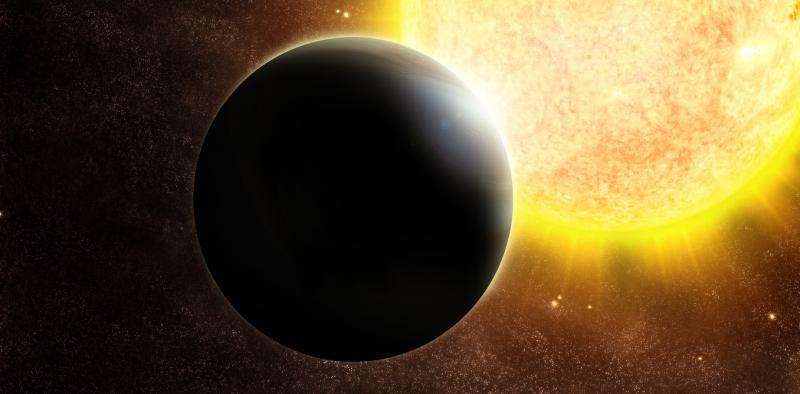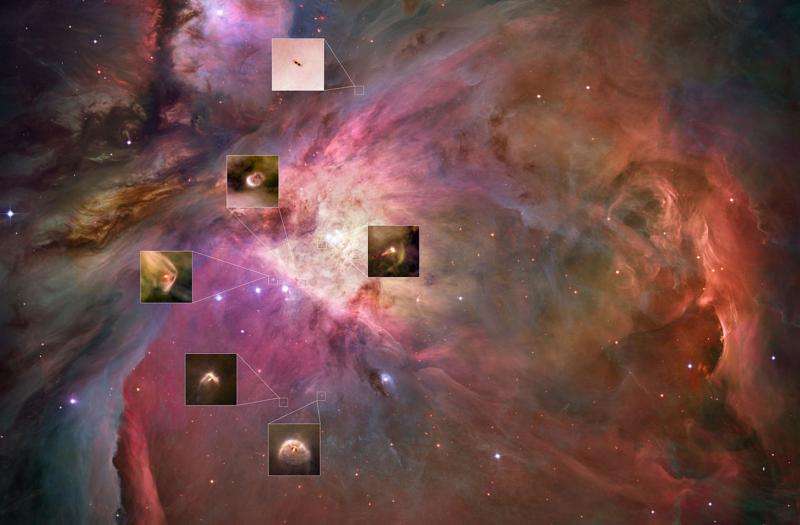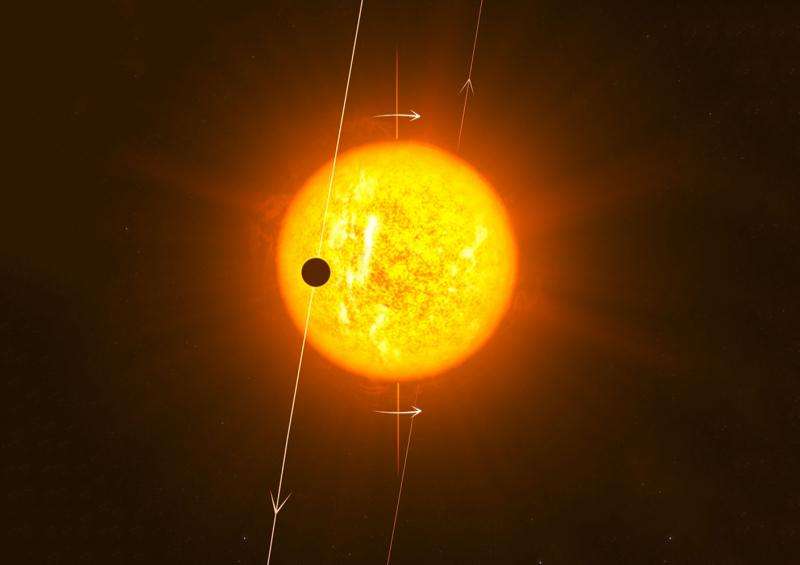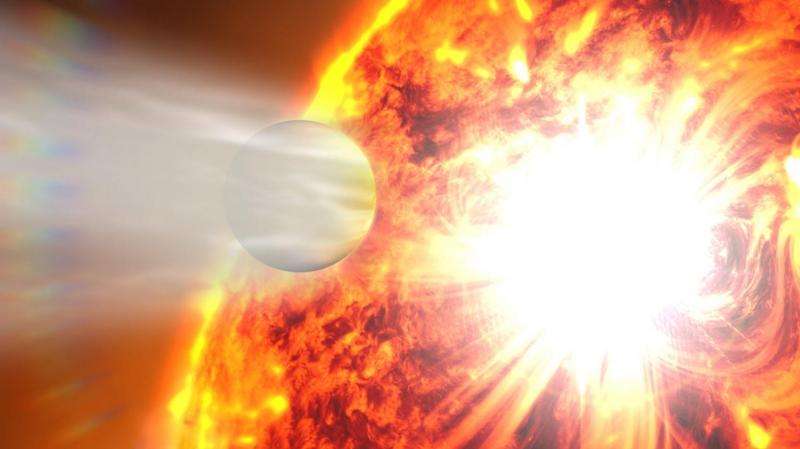Stars with planets on strange orbits: what's going on?

All the planets in our solar system orbit close to the sun's equatorial plane. Of the eight confirmed planets, the Earth's orbit is the most tilted, but even that tilt is still small, at just seven degrees.
It was natural, then, for astronomers to expect that planets orbiting other stars would behave the same way – forming and evolving on orbits aligned with their host star's equators.
But in recent years, new observations have revealed that the story is somewhat more complicated, at least for the oddest planets known, the Hot Jupiters.
An explosion of exoplanets
In just two decades, we have gone from knowing one planetary system (our own) to thousands, with 3,268 exoplanets now known. This has driven a massive rethink of our models of planetary formation.
Based on a sample of one system, astronomers once expected most planetary systems to have small, rocky planets (like Earth) orbiting close to their host star, and massive, Jupiter-like planets orbiting farther out.
With the discovery of the first exoplanets, this simple model was shattered. Those planets, the Hot Jupiters, were different from anything we had expected.
Comparable in mass to Jupiter, they move on incredibly short period orbits, almost skimming the surfaces of their host star. Instead of Jupiter's sedate 12-year orbit, they whizz around with periods of days, or even hours. Finding planets on such extreme orbits meant a major rethink.
As a result, a new suite of theories were born. Rather than planets forming sedately at a fixed distance from a star, we picture migratory planets, drifting huge distances as they grow.
The evidence for such migration abounds, even within the solar system.

Then came another set of shocking discoveries. Rather than moving in the same plane as their host star's equator, some Hot Jupiters turned out to have highly tilted orbits. Some even move on retrograde orbits, in the opposite direction to their star's rotation.
How did those planets get onto such crazy orbits?
Rethinking planet formation
The most widely accepted model of planet formation is "core accretion", where planets form slowly, in a circumstellar disk of material. We've even caught systems in the act, partway through formation.
Within those disks, dust and ice particles gradually grow by devouring their neighbours. In the hot inner reaches, the amount of solid material is limited as it is too warm for gaseous water to condense to form ice, so planets grow slowly.
Farther out, vast amounts of ice contribute to the more rapid growth of planetary cores. Eventually, those cores gain enough mass (around ten times the mass of Earth) to capture gasses from their surroundings.
When a planet reaches this critical mass, it begins to accrete gas from the disk, and undergoes rapid growth, becoming a fully fledged gas giant.
In the process, the interaction between the planet and the disk causes it to migrate inwards. Depending on the properties of the disk, the planet can move vast distances, even ending up devoured by its host.
This rapid growth and migration comes to an end when the host star clears any remaining gas and dust from the system.
The planets continue to drift as they scatter and devour the larger debris that remains. That process continues even today in the solar system, albeit at a snail's pace.

But this simple model fails to explain the latest discoveries of planets on highly inclined orbits. The migration described above typically happens within the disk, keeping the planet close to the star's equatorial plane.
To excite it to a highly inclined orbit requires something more.
Highly inclined planets
To date, astronomers have measured the orbital inclinations of 91 exoplanets and more than a third (36) move on orbits that are significantly misaligned, tilted by more than 20 degrees. Nine of them move on retrograde orbits.
Were there one or two misaligned planets, we could write them off as a fluke of nature. But the number found is far too large to be coincidence.
Astronomers have developed new models, featuring evolution that allows migrating planets to become misaligned. The most promising share a common theme, a period of high eccentricity migration.
A problem solved?
High eccentricity migration models run as follows. Giant planets form, as expected, on initially circular orbits, well aligned with their host's equator. As the systems evolve, the planet's orbit is perturbed by other massive objects in the same system (most likely, a companion star).
As a result, the planet's orbit becomes significantly less circular (more eccentric). At the same time, its inclination can be pumped up, becoming misaligned. If a planet's orbit is sufficiently tilted, compared to that of its perturber, an additional effect can kick in, known as the Kozai-Lidov mechanism.
Under the Kozai-Lidov mechanism, a planet's orbit can yaw wildly in space. As its orbit becomes more inclined (compared to the perturber), it also becomes more circular. Then the oscillation changes direction, and the orbit swings back towards that of the perturber, while becoming more eccentric.

These oscillations can be so extreme that they cause a planet to become star-grazing, skimming its host's surface with every pass. During these close encounters, the star and planet interact tidally with the planet raising tides on the star, and the star raising tides on the planet.
These tides exert a strong damping force, causing the planet's orbit to decay rapidly. The point of closest approach remains roughly the same, but the apocentre (the greatest separation distance) shrinks. The planet's orbit is rapidly circularised as it decouples from the distant perturber, but remains highly tilted.
But what comes next?
The theory makes testable predictions. To make misaligned planets this way requires a perturber.
In some cases, the companion will be long gone, the binary star system torn asunder by passing stars, for example. But for most, the smoking gun should still be there. Binary companions, waiting to be discovered.
Astronomers are using new instruments on the world's largest telescopes to attempt to detect the perturbers, if they're there.
Some stars, by chance or association, appear to be very close together. To see whether a star has a true companion isn't just a case of seeing if there's another star in the same bit of sky, though chances are, there is.
Instead, we have to watch those neighbours for months, or years. If they're truly are a couple, they'll move together, drifting in lockstep against the background stars.
One of us (Brett Addison) is currently actively involved in this search, using the Magellan Clay Telescope in Chile. The preliminary results are already in – with no strong correlations observed between systems with stellar companions and those with inclined planets.
Still, the search goes on.
Source: The Conversation
This story is published courtesy of The Conversation (under Creative Commons-Attribution/No derivatives).![]()



















